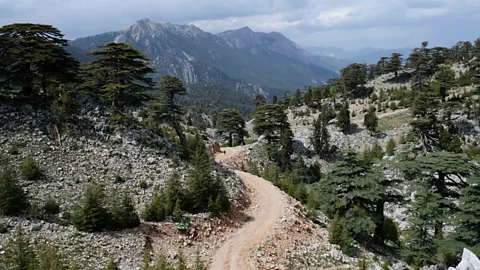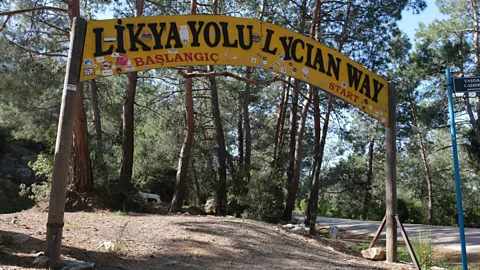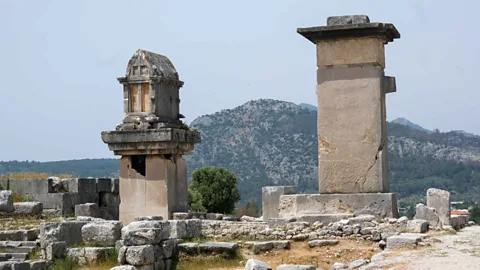The ancient civilisation that inspired US democracy
 Alastair Gill
Alastair GillA 540km trail along Turkey's Mediterranean coast introduces hikers to the rich heritage of Lycia, an ancient maritime republic that's recognised as the world's first democratic union.
"The Lycians? But who were they?" said Iskender. "When we Turks came here, all we saw was ruins, and – how do you call them? Where the dead people lie?" the old boatbuilder added, setting down his bottle of Efes beer and making a horizontal gesture with his hands.
"Tombs?" I offered. He adjusted his grubby skipper's cap and nodded.
It was only May, but the afternoon heat already weighed heavy in Simena, a remote village on the Teke Peninsula on Turkey's Mediterranean coast, a region historically known as Lycia. I was two weeks into a hike along the Lycian Way, a 540km trail linking the cities of Fethiye and Antalya, and had met Iskender after seeking refreshment in a roadside cafe near a boatyard.
He gestured towards the crenellated walls of Simena Castle, riding up a rugged ridge. "Those tombs you saw near the castle… How did they move these enormous stones, thousands of years ago?" he asked. "Even five men couldn't carry those tomb lids." Iskender shook his head, as if struggling to reconcile himself to an impossible idea.
From the fortress, I had seen the Lycian sarcophagi with their Gothic vault-shaped lids, littering the hillside in dozens. Earlier, in nearby Kaleüçağız, I had climbed a hillock overlooking the marina to find a vast necropolis of weed-choked tombs, while just metres away, traders noisily set up their stalls. The Turkish presence seemed fragile beside these eerie relics, a reminder that others had once called this land home.
 Alastair Gill
Alastair GillImmortalised in the Iliad as the land of the "swirling river Xanthos", named after its original capital, ancient Lycia was a mountain stronghold peopled by a fiercely independent seafaring race whose origins remain a matter of speculation.
The ancient Greek historian Herodotus claimed that the forebears of the Lycians, the Trm̃mili, "sprang originally from Crete", though modern-day scholars believe they were an Anatolian people who became Hellenised after Alexander the Great seized the region from the Persians in 333 BCE. And although the Lycians vanished into oblivion long ago, assimilated by Byzantines and Turks, their political legacy lingers on, thanks to a curious historical connection.
The Lycian Way
What: Long-distance hiking trail
Length: 540km
Duration: Approx 30 days
Start/Finish: Fethiye/Geyikbayari (20km west of Antalya)
Stay: Wild camping or guesthouses/hotels along the route
Best time: March-May or September-November
On 30 June 1787, future US president James Madison gave a speech at the Constitutional Convention in Philadelphia. The forum had been convened to identify a more effective system of government for the fledgling nation, where a lack of proportional representation was hampering effective policymaking.
Responding to delegate Oliver Ellsworth's assertion that equality of voices had always been a fundamental principle in confederations, Madison cited the example of Lycia. The Lycian League, he argued, was different.
Formed in the 2nd Century BCE and composed of 23 city-states, the Lycian League was the world's first democratic union, a model of a strong confederacy based on popular and proportional representation. Six cities – including the capital Patara – wielded three votes in the Lycian Council, medium-sized cities commanded two, and small settlements had one.
 Alastair Gill
Alastair GillThe circumstances surrounding the League's creation are unclear, but it was probably a response to the tyranny of Rhodes, which was briefly assigned control of Lycia in 190 BCE by Rome. The League could not determine foreign policy, but elected a governing executive, a Lyciarch, as well as local judges, and collected taxes. The 18th-century French philosopher Montesquieu called it "the most perfect constitution of antiquity",
Professor Anthony Keen, an expert on Lycia from the University of Notre Dame, describes the system as "a meeting of Greek ideas about democracy with pre-existing Lycian ideas about how a community of individual urban settlements works together".
Many of the paths I was walking were once roads, millennial arteries connecting the cities of Lycia, whose story ended after Roman emperor Claudius annexed the region in 43 CE. It was an interest in these ancient byways that spurred Kate Clow to create the Lycian Way in the 1990s after moving to the region.
"I wasn't inspired to make a trail; I was inspired to collect old roads," she said.
Clow continues to expand the route and support local communities: this year a volunteer group transformed a building in the village of Sidyma into a cultural centre.
Hikers were few on the Lycian Way, but the trail was full of life: shaggy-haired goats, ponderous tortoises and, more alarmingly, the black snakes that occasionally darted across the path.
 Alastair Gill
Alastair GillIn mountain villages spangled with poppies and wildflowers, women in baggy şalvar trousers brought me goat cheese, fresh honey and gozleme flatbread, washed down with glasses of tea. During the hottest hours I plunged into the sea, sheltered in forested canyons or stretched out in thyme-scented groves of oak, wild olive and dogwood. After dusk, a thick silence enveloped the land, and my campfire trembled beneath the whispering pines, as if urging me to remember the people who built these roads.
Indeed, on the Lycian Way, memory is such a pervasive presence that you walk, rest and sleep in the company of phantoms. For despite its dramatic beauty, this is a land of ghosts. In The Lycian Shore, an account of a journey along the peninsula by sea in the 1950s, the explorer Freya Stark called it "the most haunted coast in the world". Empty tombs lie in every thicket and grove, like mute envoys sent down from a vanished embassy.
An ostentatious part of Lycia's urban fabric, tombs were an expression of the central role of ancestor worship and the afterlife. Strangest of all were the tower-like pillar tombs found in the ruins of Xanthos, capital of Lycia under the Persians. The Lycian Way diverts inland to the site, which sits on a rocky outcrop surrounded by greenhouses and orange plantations. Two pillar tombs dominate the acropolis: the Harpy Tomb, adorned with reliefs of female winged figures; and the Xanthian Obelisk, a giant stele covered in Lycian script that has not yet been fully deciphered.
Xanthos' greatest pillar tomb, the Tomb of Payava, with its bas-reliefs and Lycian inscriptions, was removed in 1841 by British archaeologist Sir Charles Fellows, who carted off all he could to London on the HMS Beacon. Today the tomb stands in the British Museum, alongside the original friezes from the Harpy Tomb, and the Nereid Monument, a spectacular sculptured tomb in the form of a Greek temple.
 Alastair Gill
Alastair GillFrom the 4th Century BCE onwards, the Lycians built rock-hewn "house" tombs – often funeral chambers carved into cliffs, with the rock face around the doorway cut to imitate the façade of a wooden Lycian house, complete with "timbers" and protruding "joists". Most common are the sarcophagi, oblong tombs cut from Lycian limestone, typically sitting atop a lower sepulchre.
Dr Catherine Draycott, an archaeologist from Durham University, explained that in Lycian tombs the deceased would be buried in the upper sarcophagus, while relatives or slaves were interred in the chamber beneath. "There is this idea in Lycia of literally elevating important people in death," she said. "So, in that sense, they're heroising whoever is put in there."
While the ubiquitous tombs have given archaeologists an understanding of the Lycians' elaborate burial rituals, the picture of everyday life is sparse: finds of personal items or jewellery are incredibly rare. "The difficulty is that a lot of the hard evidence is Roman. There's so little from the earlier periods," said Draycott. Plundered long ago, the tombs are inevitably empty – even the bones are gone.
Two days on from Xanthos, the trail brought me back to the coast by the ruins of Patara, capital of the Lycian League. Once a thriving port, Patara was gradually abandoned after its river silted up. The colonnaded main street now disappears into a pool, and the walls of the shops that once lined the avenue have long since collapsed. The most significant building here is the Council Chamber, or bouleterion. Containing a semi-circular auditorium with 20 rows of stone benches, this recently restored assembly house was the political centre of the Lycian League.
 Berk Ozdemir/Getty Images
Berk Ozdemir/Getty ImagesSitting high up in the bouleterion, it wasn't hard to imagine hundreds of robed delegates discussing public affairs while the Lyciarch conducted proceedings, and my thoughts drifted from Patara to distant Philadelphia, and Madison's invocation of the Lycian League.
It is thanks to Madison that today the US House of Representatives is founded on the Lycian principle, with the 435 seats apportioned among the 50 states in proportion to their population. Of all the Lycians' attempts to defy the passage of time and preserve themselves for the next world, the one that turned out to have a true afterlife was the most intangible of things – an idea.
Places That Changed the World is a BBC Travel series looking into how a destination has made a significant impact on the entire planet.
---
If you liked this story, sign up for the weekly bbc.com features newsletter called "The Essential List". A handpicked selection of stories from BBC Future, Culture, Worklife and Travel, delivered to your inbox every Friday.
